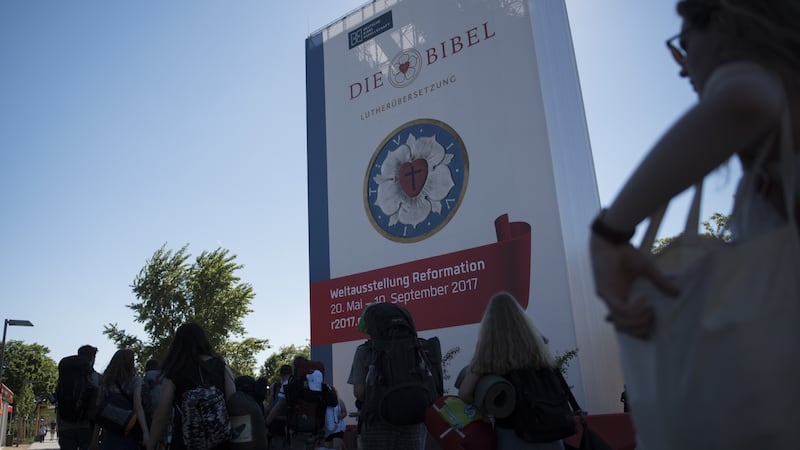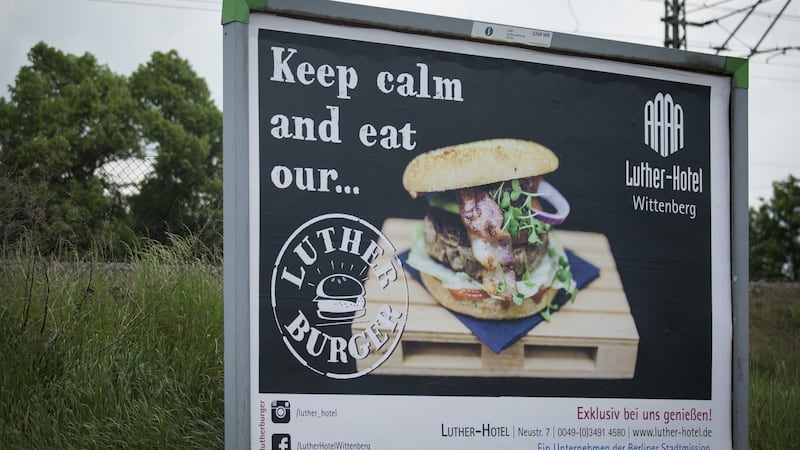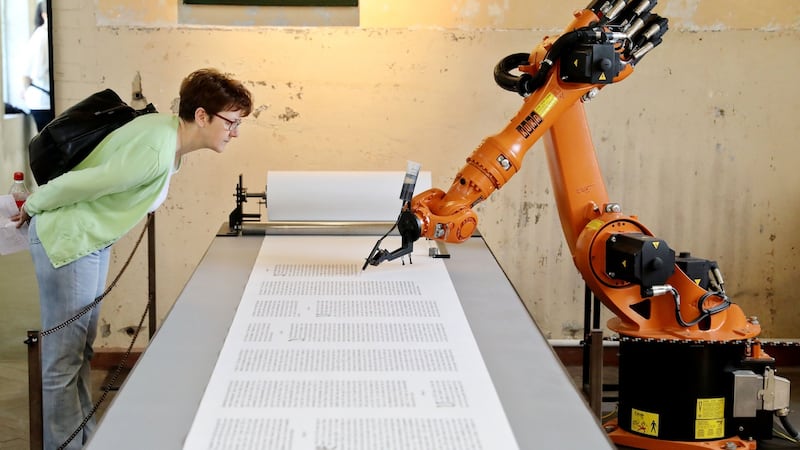The eastern German town of Wittenberg, half an hour by train south of Berlin, looks as if it’s ready to storm the Tidy Towns World Cup. On a sunny summer’s day its grey communist past is a distant memory: every facade is freshly painted, every cracked footpath has been repaved, and newly planted flowers blossom beside a massive book standing on its end. The greatest story ever told is now the world’s largest Bible: 27m high, with a viewing platform on top and every word of the New Testament on one side.
The XL bible is good news indeed, a welcome sign that the Berlin visitors are in the right place. The second sign, as they block traffic briefly on the roundabout, is the local taxi diver who swerves around them, shouting: “God almighty!”
It's 500 years since another angry German, the theologian and Augustinian hermit Martin Luther, shouted something similar, furious at the crooked travesty that the 16th-century church had become.

Tired of mañana reform promises, Luther got out his quill and wrote one of the great letters of complaint. He sent the furious missive, containing 95 theses, to his bishop. Finally, in the most far-reaching use of a hammer and nails since the Crucifixion, Luther reportedly posted a copy on the door of All Saints' Church in Wittenberg "out of love for the truth and from desire to elucidate it".
It was October 31st, 1517, and the world would never be the same again.
Life and times
To understand Martin Luther's life and times it's worth stopping off after arrival at the staggering cylindrical panoramaby the Austrian-born artist Yadegar Asisi. Step inside the panorama – 18m high and 29m in circumference – and you are transported back to the cold, wet days of October 1517.
Using real people, photographed in period costume in a re-creation of Wittenberg at the time, the panorama shows the local nobleman Frederick the Wise riding out on horseback to the market place. Before him people are queuing to buy indulgences – express-lane passes to heaven, sold with a papal blessing to finance the rebuilding of St Peter’s Basilica, in Rome. Standing nearby, arguing with gullible locals, is a livid Martin Luther.
“He who sees a needy man and passes him by, yet gives his money for indulgences, does not buy papal indulgences but God’s wrath,” he would write in thesis 45. “Any true Christian, whether living or dead, participates in all the blessings of Christ and the church, and this is granted him by God, even without indulgence letters.”
Within two months his theses had reached every corner of Europe, lapped up by people tired of their hypocritical and corrupt clergy. A ban on his writings by Pope Leo X was pointless: the genie was out of the bottle.
Reform, not revolution
For the Luther biographer Heinz Schilling the 95 theses were the “greatest media sensation of the age”, but they began life as a demand for reform, not revolution – something that might still have been possible in 1517 if rhetorical moderation and cool heads had prevailed.
“Instead what resulted was antagonistic systemic competition and fundamental antagonism, causing Europe to hold its breath for generations,” he says.
In a series of showdowns with papal legations, Luther refused to budge and even hardened his line. In 1520 he set fire to a papal edict demanding he recant or be excommunicated and in April 1521, after rejecting a last chance to recant or be dubbed a heretic, he went on the run.
Living underground, supported by growing numbers of followers, Luther formalised his reforming teachings, effectively urging followers to cut out the middle man.

In 1520 he wrote that believers needed Christ, faith and mercy – not priests – to be saved. That was a Copernican jolt to the world order, followed two years later by a vernacular translation of the Bible that, literally and figuratively, returned the Christian faith to the people.
Luther’s break with Rome shattered Christian identity but boosted efforts to unite the previously fragmented German national identity.
Three decades after his death, in 1546, a painting by his friend and supporter Lucas Cranach sums up Luther’s legacy from his supporters’ perspective.
The “vineyard of the Lord”, once solely in Rome’s hands, is now subdivided: on the right pious Protestants calmly gather the grapes of salvation, on the left are chaotic Catholics and hypocritical clergy, who poison the vines; the pope is pictured, hand out, demanding wages from Christ himself.
Half a millennium after that first domino fell – toppling institutions and sparking countless wars – the rupture remains, and Luther’s legacy is still ever present.
“The Reformation, and the Catholic reforms that followed a few decades later in response, brought a complete and fundamental overhaul of the European order,” Prof Schilling says. “This all sent out considerable impulses for the creation of our modern world.”
The Lutheran theologian Margot Kässmann agrees. A former head of the Lutheran church in Germany, and world ambassador for the 500th anniversary, Dr Kässmann says Luther reformed not just religion but also our understanding of what makes us human, and European.
“Luther said that, in matters of belief and conscience, every person was free, a huge step in the enlightenment and modernisation process,” she says. “He demanded that people, based on their faith, take a position – everyone for themselves, individually. Such a stance is still required today.”
At a staggering cost of €50 million Wittenberg’s reformation anniversary, which runs until September, is a huge endeavour for a town of 50,000 people, not least because East Germany’s legacy means just 18 per cent of people here say they are religious – and 12 per cent Lutheran.

Walking around the pretty town, which has never looked as well as it does today, it’s clear that Wittenberg sees this as a once-in-a-lifetime chance.
“Our hope is not to just have a celebration of religion but to use this as a sustainable investment in our future,” Torsten Zugehör, its mayor, says.
There is a remarkable array of things to see and do in a small space. As well as historic sites – Luther’s rooms, or All Saints’ Church – visitors can try counselling in a ferris-wheel cabin, get a blessing from a robot pastor or wet their whistle at the historic beer fountain.
A glut of exhibitions, magazines and books, in all of eastern Germany, explain Luther’s difficult character and examine the problematic sides of his writing, not least his rantings against Jews used later by the Nazis used to justify their politics of persecution.
Remarkable exhibition
Wittenberg is also home to a remarkable exhibition, " Luther and the Avant Garde", staged in an old city prison. This showcases thought-provoking works from 65 artists, including Ai Wei-Wei and Olafur Eliasson.
Although most works look back to Luther's clashes with Rome, one clever exhibit – a vast, blocky image in the garden of the prison – reveals itself, when viewed from above, as the portrait of another man with Luther-like troubles today: Edward Snowden.
A trip to Wittenberg is more than worthwhile if you want to understand better what makes Germans, not least Chancellor Angela Merkel, a Lutheran pastor’s daughter, tick. Wandering the city’s themed exhibition areas – life, death, globalisation, the environment – it’s clear that, despite dipping church attendance, Martin Luther’s followers today see an important role for their church at the start of the 21st century.
“With so many big questions facing humanity we cannot expect politicians to come up with all the answers,” Pastor Christof Vetter, one of the Luther 500 organisers, says.
“Who else but the major churches have the capacity to discuss these questions and help people with the answers they are demanding?”










